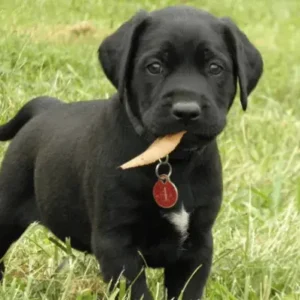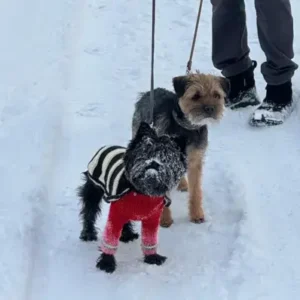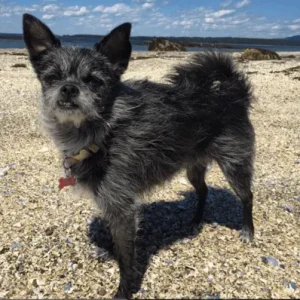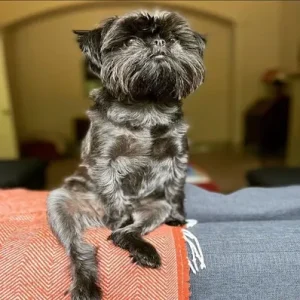Bedlington Terrier History
The Bedlington Terrier dog originates from Bedlington, Northumberland, England, where it was initially used by gypsies and poachers for hunting small game. Its hunting abilities attracted the attention of the gentry, who later on employed it for vermin control on their estates.
Notably, the breed gained popularity among coal miners for its prowess in rat control and for participating in races against other breeds like Whippets. While its exact ancestry is uncertain, it shares similarities with breeds such as the Dandie Dinmont, Soft-Coated Wheaten Terrier, and Kerry Blue.
Joseph Ainsley is credited with breeding the first Bedlington Terrier in 1825, named Ainsley’s Piper. It was recognized by the American Kennel Club in 1886 under Terrier Group.
Bedlington Terrier,1925- Source: AKC.org
By the early 1900s, the breed transitioned to become a beloved companion dog, known for its lamb-like appearance coupled with terrier instincts.
Today, the Bedlington Terrier continues to charm with its unique blend of elegance and tenacity.
Painting of a Bedlington Terrier,1881- Source: Wikipedia
Bedlington Terrier Personality
Bedlington Terriers are one of the dog breeds characterized by their gentle and affectionate demeanor, making them wonderful companions. They possess the typical terrier spirit, displaying a lively and spirited nature.
- Bedlington Terrier Temperament
These purebred dogs are high-energy so it’s important to keep them physically and mentally stimulated. However, their hunting instincts may lead them to chase small animals outside. Despite this, they can be trained to coexist peacefully with other indoor pets.
Bedlington Terriers have a gentle and affectionate temperament indoors like that of a lamb. They form strong bonds with their human family members and are particularly fond of children.
Overall, they are friendly and playful dogs that thrive in active households where they are cherished members of the family. Training Bedlington Terriers from an early age is vital for making sure they are well-behaved pets.
- Potential Challenges
Like any breed, Bedlington Terriers can exhibit a range of behaviors and personality traits influenced by factors such as genetics, upbringing, and socialization. While the breed may generally be characterized by traits such as liveliness and spiritedness.
However individual dogs may display a wide spectrum of temperaments, including variations in energy levels, sociability, and reactivity.
For prospective owners considering a Bedlington Terrier, it’s crucial to understand that each dog is unique and may possess its temperament quirks and tendencies. Some Bedlington Terriers may indeed be gentle and affectionate. On the other hand, others may exhibit behaviors such as shyness, aggression, or anxiety under certain circumstances.
Bedlington Terrier Physical Appearance
Bedlington Terriers have a sleek body with a deep chest and well-sprung ribs. Their legs are long and slender, providing them with agility and grace in movement.
One of the most distinctive aspects of their appearance is their pear-shaped head, which are slightly rounded and gives them an endearing expression. Additionally, Bedlington Terriers have an arched back that adds to their graceful stance.
- Bedlington Terrier Size
The Bedlington Terrier is a medium-sized breed, standing between 15 to 17 inches (38 to 43 cm) tall at the shoulder. Despite their moderate height, they possess a sturdy build with well-proportioned features.
- Coat Color
Common coat colors include liver, blue, sandy, or tan, with variations and combinations within these hues. The texture of their single coat is another notable characteristic, as it is dense and wiry, protecting from the elements.
Many Bedlington Terriers also sport a lighter-colored topknot on their head, adding to their distinctive appearance.
Silver Bedlington Terrier- Source: rosiethebedlington
Sand Bedlington Terrier- Source: bedlington_terrier_ig
Bedlington Terrier Gender Differences
While Bedlington Terriers exhibit minimal gender differences, there are some subtle distinctions between males and females.
Males tend to be slightly larger than females, typically standing between 16 to 17 inches tall at the shoulder, whereas females generally range from 15 to 16 inches in height. This slight variation in size may result in males being an inch or two taller than females on average.
In terms of behavior and temperament, there are no notable differences between male and female Bedlington Terriers. Both genders are known for their loving and gentle nature, provided they receive proper training and socialization from an early age.
Bedlington Terrier Feed/Nutrition
Proper nutrition is crucial for the health of your Bedlington Terrier. Choose high-quality dog food with protein sources like chicken, shrimp or beef, ensuring a balanced diet with carbohydrates, fats, vitamins, and minerals.
Portion control is essential to prevent overfeeding and obesity. Always provide fresh water, and consult with your vet to tailor a nutrition plan to your dog’s needs, considering factors like age and activity level.
Monitor their weight regularly and avoid feeding them table scraps, focusing instead on a diet that supports their active lifestyle and overall well-being.
Bedlington Terrier Health Issues
While generally healthy, Bedlington Terriers may be prone to certain inherited conditions:
- Copper Toxicosis: This is a genetic disorder characterized by an abnormal accumulation of copper in the liver, leading to liver damage and dysfunction. Symptoms may include lethargy, jaundice, vomiting, and abdominal pain.
- Patellar Luxation: Patellar luxation is a condition where the kneecap (patella) is dislocated from its normal position, causing lameness and discomfort. It can range from mild to severe, and affected dogs may exhibit intermittent limping or reluctance to put weight on the affected limb.
- Renal Cortical Hypoplasia: This is a congenital condition characterized by underdevelopment of the renal cortex, which can lead to impaired kidney function. Symptoms may include increased thirst and urination, dehydration, and weight loss.
Bedlington Terrier Care and Grooming
Bedlington Terriers, despite being non-shedding, require high-maintenance grooming. Their coat needs to be brushed at least once a week. Regular trimming or clipping is necessary to maintain their distinctive appearance.
Prospective owners considering a Bedlington Terrier as a companion should be aware of the breed’s specific grooming requirements and potential health concerns. Bedlington Terriers possess a unique coat that demands regular maintenance to preserve its distinctive appearance and prevent matting.
Grooming Bedlington Terrier- Source: dogsbylogan
This entails weekly brushing to remove tangles and debris, as well as periodic trimming or clipping to shape the coat and prevent overgrowth. Many owners opt for professional grooming services to manage intricate tasks like maintaining the characteristic “topknot.”
Additionally, leash training your dog is important to ensure enjoyable walks and good behavior in public spaces.
Buy or Adopt Bedlington Terrier
If you’re considering Bedlington Terrier adoption, several rescue organizations specialize in rehoming this dog breed:
Bedlington Terrier Price
The price of a Bedlington Terrier typically ranges from $800 to $2,000, depending on the breeder and the dog’s lineage.
When buying a p puppy, choose a reputable breeder prioritizing dog health and welfare. Avoid puppy mills and irresponsible breeders.
Interesting Facts
- The first dog Bedlington Terrier was an 8-month-old dog, known as Ainsley’s Piper, who was used for hunting. This dog hunted down otters and badgers with great speed and skill.
- The Bedlington Terrier is also sometimes called Ruthford’s Terrier or Ruthford’s Lamb since it was one of Lord Ruthford’s favorites when he was brought to Bedlington town.
- They have been featured in the breed judging show 2022.
Best For
Bedlington Terriers make great pets for families seeking affectionate and playful pets with high energy levels.
Top Names
| Male Bedlington Terrier Names | Female Bedlington Terrier Names |
| Baxter | Willow |
| Rufus | Maisie |
| Monty | Poppy |
| Angus | Tilly |
| Dexter | Ivy |

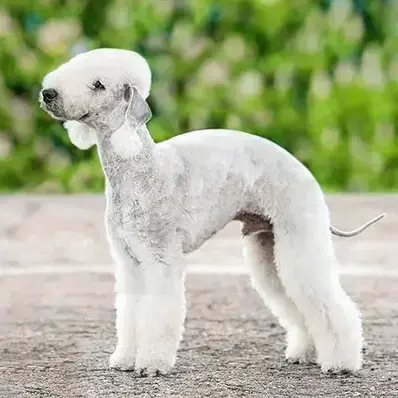







 Bedlington Terrier,1925- Source:
Bedlington Terrier,1925- Source:  Painting of a Bedlington Terrier,1881- Source:
Painting of a Bedlington Terrier,1881- Source: 

 Silver Bedlington Terrier- Source:
Silver Bedlington Terrier- Source:  Sand Bedlington Terrier- Source:
Sand Bedlington Terrier- Source:  Grooming Bedlington Terrier- Source:
Grooming Bedlington Terrier- Source: 


